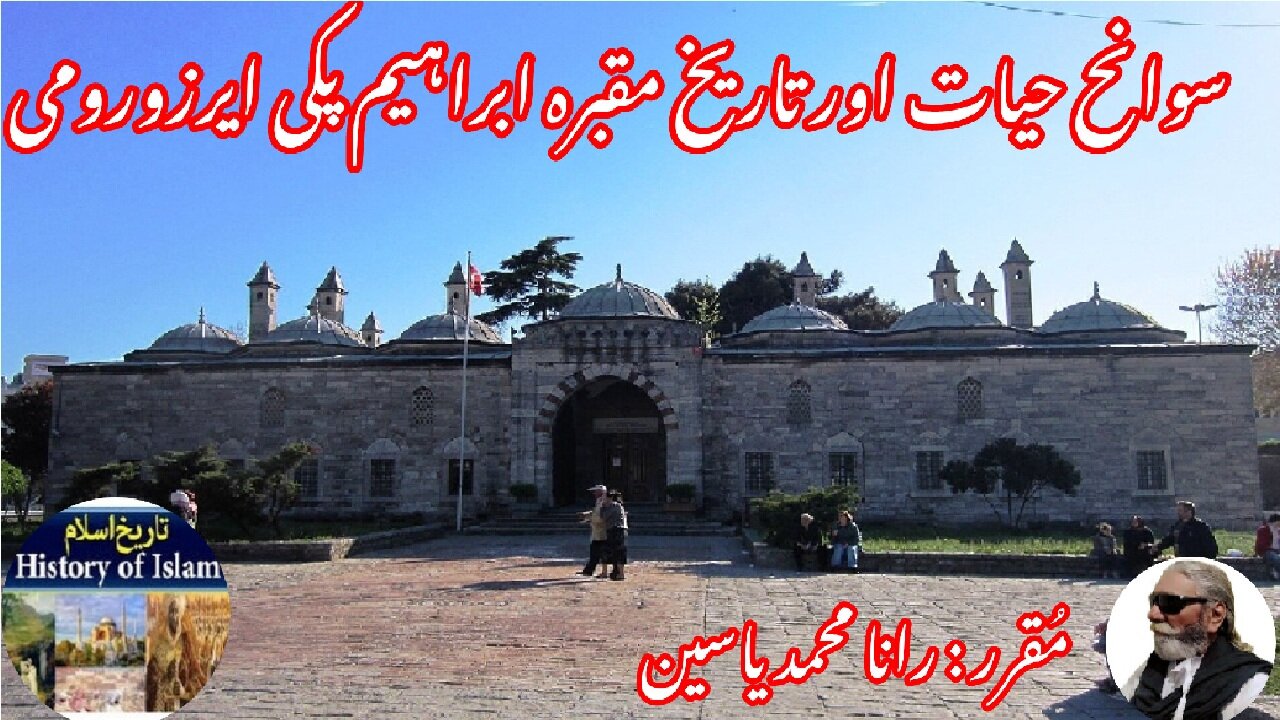Premium Only Content

Ibrahim Hakki Erzurumi | इब्राहीम हक्की | ابراہیم ہکی ایرزوومی کی سوانح عمری اور ان کے مزار کی تاریخ
@islamichistory813 #sufisaint #culturalheritage #biography #ibrahimhakkierzurumi #islamicmysticism #islamicphilosophy #shrine #historicalfigures
Biography of Ibrahim Hakki Erzurumi and the history of his shrine
Dekhti Aankhooon aur sountay kaanoon ko Asslamoalaikum, sisters, brothers friends and elders, in informative series videos of Islamic ascolars, sufisaints, cultural heritages, islamic philosophys, islamic mysticisms and historical figures. today we are describing biography of Ibrahim Hakki Erzurumi and the history of his shrine.
Ibrahim Hakki Erzurumi, a popular Turkish Sufi saint of the Ottoman Empire from Erzurum in eastern Anatolia who was a polymath, mystic, poet, author, astronomer, physicist, physician, psychologist, sociologist, philosopher, Hanafi Maturidi Islamic scholar and encyclopedist.
Having lost his mother and later his father at an early age, Ibrahim Hakk? was raised by his uncle who educated him for a while. He met the Ottoman Sultan Mahmut I at Istanbul in 1747. He returned to Erzurum, and was continuously interested in religious and scientific matters. Having written 15 books in the manzum and regular styles and a great number in Turkish, Arabic, and Persian languages, amongst Ibrahim Hakki's most important works are the Divan and Marifetname.
Ibrahim Hakk? Erzurumi, born on May 18, 1703, in Hasankale (now Pasinler) near Erzurum, was a distinguished Ottoman polymath, Sufi mystic, and scholar. His extensive contributions spanned various disciplines, including astronomy, mathematics, anatomy, psychology, philosophy, and Islamic mysticism. He is best known for his encyclopedic work, the "Marifetname" (Book of Gnosis), which reflects his profound knowledge and spiritual insight.
Ibrahim Hakk? faced the loss of his mother at a young age, followed by his father's death. He was subsequently raised and educated by his uncle, who provided him with foundational knowledge in religious and scientific subjects. In 1747, during a visit to Istanbul, he had the opportunity to meet Ottoman Sultan Mahmut I, an encounter that likely influenced his intellectual pursuits. After returning to Erzurum, he dedicated himself to continuous study and writing, producing works in Turkish, Arabic, and Persian.
Completed in 1756, the "Marifetname" is Ibrahim Hakk?'s magnum opus. This comprehensive work encompasses a wide range of topics, including astronomy, mathematics, anatomy, psychology, philosophy, and Sufism. Notably, it contains one of the earliest treatments of post-Copernican astronomy by a Muslim scholar, demonstrating his engagement with contemporary scientific developments. The "Marifetname" was written in accessible language, aiming to educate the general populace, and is said to have been compiled from over 400 sources. An English translation was published in 2010, expanding its reach to a global audience.
Central to Ibrahim Hakk?'s philosophy was the belief that self-examination is essential in the quest to discover God. He emphasized that by taking a step towards Allah, one would find Allah coming towards them, a concept derived from a hadith qudsi. His most renowned poem, "Hak ?erleri Hayr Eyler" ("The Truth [God] Makes Evils Turn Out Good"), reflects his deep spiritual insight and has been adapted into a religious hymn.
Ibrahim Hakk?'s devotion to his mentor, Ismail Fakirullah, is immortalized through an ingenious architectural feat in Tillo, Siirt Province. He constructed a mechanism designed to honor his teacher by ensuring that the first light of the new year would illuminate Ismail Fakirullah's tomb. This system involved a tower and a strategically placed wall, known as Kalet’ül Üstad, located on a hill overlooking the Botan Valley. On specific dates, such as March 21 and September 23, the rising sun's light passes through an opening in the wall, reflects off a mechanism in the tower, and illuminates the cenotaph of Ismail Fakirullah. This phenomenon, lasting approximately six minutes, showcases Ibrahim Hakk?'s expertise in astronomy and architecture, as well as his deep respect for his mentor.
Ibrahim Hakk? spent his later years in Tillo, where he continued his scholarly and spiritual endeavors until his passing on June 22, 1780. He was laid to rest near his mentor, Ismail Fakirullah, in Tillo. His shrine has become a site of reverence, attracting visitors who seek to honor his memory and contributions. The nearly three-century-old light refraction system he designed continues to function, symbolizing the enduring nature of his intellectual and spiritual legacy.
Ibrahim Hakk? Erzurumi's life and works exemplify the rich intellectual and spiritual traditions of the Ottoman Empire. His interdisciplinary approach, combining scientific inquiry with deep religious devotion, serves as an inspiration for scholars and seekers of knowledge. The "Marifetname" remains a testament to his encyclopedic intellect, while the architectural marvel in Tillo reflects his ingenuity and enduring respect for his mentors. His legacy continues to illuminate the path for those who strive to integrate knowledge and spirituality in their lives.
He died and was buried in Tillo of Siirt Province.
With this, we seek your permission until tomorrow, tomorrow we will describe the biography of Sidi Boushaki and the history of his Shrine. Allah Hafiz.
==========================
-
 13:59
13:59
ISLAMIC HISTORY
1 day agoIslamic History Episode 65 Exploits of Abu Ubaidah bin Mas'ud कारनामे ابو عبیدہ بن مسعود کے کارنامے
15 -
 2:45:19
2:45:19
TimcastIRL
6 hours agoTrump THREATENS 50% Tariff Increase After Market CHAOS, Tells China BACK OFF
204K92 -
 1:56:17
1:56:17
Badlands Media
13 hours agoBaseless Conspiracies Ep. 127: The Satanic Fed Op Behind 764, Pedo Networks & Psychological Warfare with Special Guest, BK
60.2K30 -
 1:05:32
1:05:32
Donald Trump Jr.
12 hours agoNews Not Noise, Live with Power the Future's Daniel Turner | TRIGGERED Ep.231
172K82 -
 28:01
28:01
Side Scrollers Podcast
5 hours agoNEW SERIES! Smash JT Has a Full-On Meltdown | Nerd Duel ft. Lady Desiree & You, Me & The Movies
28.1K2 -
 2:13:28
2:13:28
I_Came_With_Fire_Podcast
7 hours agoMEAD & MENTAL HEALTH WITH I CAME WITH FIRE AND VOC!!!
38K4 -
 1:10:04
1:10:04
John Crump Live
4 hours ago $2.59 earnedYes I talked To The ATF
30.7K3 -
 6:01:28
6:01:28
Amish Zaku
7 hours agoVerDanceKey Warzone - Birthday Fun
33.1K5 -
 LIVE
LIVE
NeoX5
4 hours agoKhazan: The Road Less Taken | Part 5-2 | Rumble Studio | Rumble Gaming
260 watching -
 LIVE
LIVE
TwinGatz
10 hours ago🔴LIVE - He Is Doing His Best | ARMA Reforger
561 watching